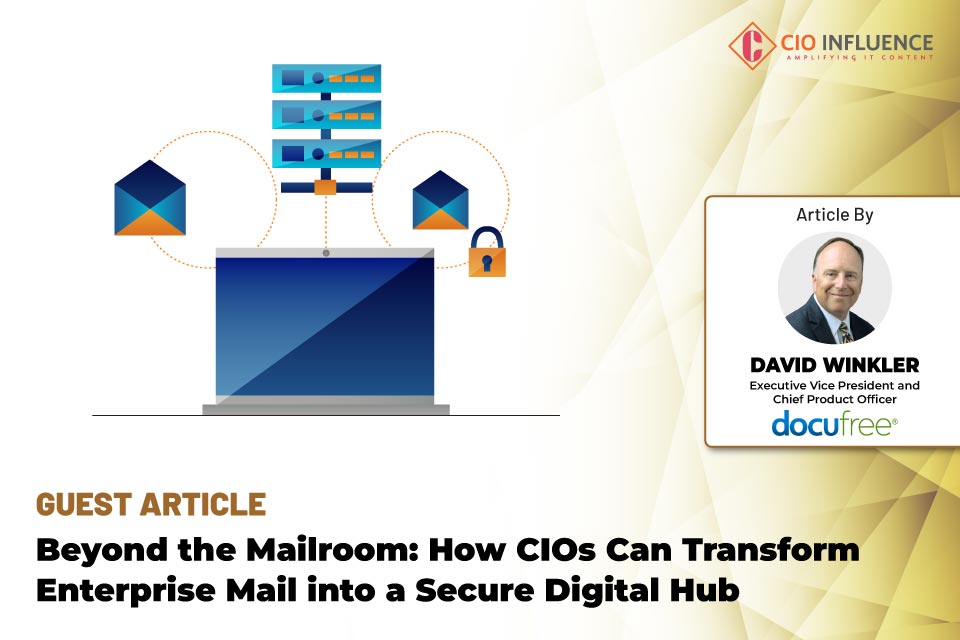This article was originally published on Entrepreneur.
Market research firm IDC has projected that spending on technologies and services that enable digital transformation of businesses will hit $1.97 trillion in 2022. One of the best places for an organization to jumpstart its digital transformation is the mailroom — the main point of entry for documents. On-premise mailrooms are slow, error prone, require too much labor and valuable real estate — not to mention they simply cannot support today’s “new world of work.”
Physical mailrooms are inefficient workflow dinosaurs
According to IDC, companies lose 20 to 30 percent in revenue every year due to inefficiencies. An outdated, physical mailroom is one of the most inefficient operational siloes for companies today.
At issue? The inordinate number of documents arriving in paper form. Companies — large and small — have business-essential mail streams coming through the U.S. Postal Service in physical form that have to be captured; data extracted; and then married with electronic counterparts. Manual mailroom workflows turn this process into a logistical nightmare — even with a dedicated administrative staff responsible for opening, copying, scanning, sending and/or uploading documents to various other systems.
How a company approaches processing and managing information from the mailroom has a direct impact on core business operations in every department. Invoices, contracts, purchase orders, client communications and expense reports are just a few examples of the myriad of business documents received in volume each day.
Among the problems physical mailrooms create:
Protracted and unproductive mail processing
The traditional mail-delivery process begins with a staff member opening the correspondence, logging it, and determining who gets it internally. Then, it’s often hand delivered to the appropriate party, who then reads it and either files it away or scans a copy to share by email or, even worse, makes multiple hard copies to distribute internally.
Information gridlock and workflow bottlenecks
Companies that rely on these cumbersome methods can quickly find themselves mired in mounting document piles and workflow bottlenecks trying to process all this information manually.
Risks of more human errors
The manual handling of mail creates an environment ripe for human errors to creep in. From internal routing mistakes and inaccurate data entry to scanning exceptions and misfiling, errors can be numerous — and, if uncaught, can often result in negative operational impacts downstream.
Too many sources and formats to manage
The exchange of information today comes in from more sources than ever before — customers, prospects, suppliers and colleagues — across multiple communication channels and in a number of different formats. Each requiring its own process for handling.
A digital mailroom can help companies overcome these challenges and begin to transition their operations to include more data-centric workflows that have become a necessity in today’s digital business world.
A digital mailroom combines document capture and management with automated workflow technology to digitize the secure inbound and outbound delivery of mail, resulting in a positive impact across the entire organization. Organizations with little or no previous experience with mailroom automation are often reticent about embarking on what may seem like another daunting IT project. However, there are a number of fundamental things that business leaders should understand about implementing a digital mailroom as well as the benefits they should come to expect.
Dispelling digital mailroom myths
While interest in digital mailrooms has certainly been accelerated by the new world of work, misperceptions exist that might hinder companies from taking action. Below are four debunked digital mailroom myths:
- Digital mailrooms aren’t engineered for large, multi-location enterprises. Many companies view digital mailrooms as virtual or online access to postal mail, more geared toward smaller businesses. They don’t realize a digital mailroom service can be used to manage both inbound and outbound mail throughout the entire enterprise, across multiple locations — whether information is in physical or electronic format.
- Huge volumes of physical mail can overwhelm a digital service. Facility-management teams are often among the last to see the feasibility and benefit of eliminating a physical mailroom that might handle thousands of pieces of mail in a month. Digital mailroom solutions exist in the marketplace today that are purpose-built to easily scale enough to handle large volumes of different types of mail.
- Basic document-management software performs the same functions. Document scan and capture addresses only one portion of the total digital mailroom experience. Beyond this, the question becomes how quickly, seamlessly and accurately can that information be incorporated into organizational workflows and integrated with other enterprise applications?
- Previously, companies had to involve multiple vendors offering piece-and-part technologies to build full digital mailroom capabilities. Modern digital mailroom services are built on a secure cloud platform and require no capital expenditures, eliminating your most costly transactions — those documents still in paper form.
Benefits of automated mail workflows
Organizations can realize a number of benefits across the enterprise from automating their mail workflows. Among them:
Boosted Productivity
Having the ability to process both inbound and outbound mail in a matter of seconds, then quickly upload the information to other corporate systems enhances productivity immensely.
More Accountability
The ability to attach “a timer” to every piece of mail that comes in helps improve accountability across the organization. In addition to knowing when a mail piece is received, opened, and placed in someone’s queue to be processed, organizations can gain insight into how long it took someone to process his or her mail — this week, this month, this year — compared to others in the office.
Deeper Visibility
Digital mailroom solutions have the ability to provide extra visibility into what’s going on with both inbound and outbound mail through a number of customizable dashboards and reports. Organizations can gain real-time insight into how many pieces of mail are being processed, the different document types, the number of pages, and where a document may be in a workflow.
Reinforced Compliance.
This type of automation creates a detailed audit trail for every single piece of inbound mail. All inbound mail, whether email, fax, U.S. Postal Service, or overnight mail comes into a common-capture platform. Mail is processed in the same manner, in an encrypted format, every single time. The encrypted documents go through the workflow and are uploaded to corporate systems — creating a new level of security that all information is processed, housed and shared in a compliant fashion (for example, meeting PCI certifications, SOC 2 certifications, etc.).
Gartner, Inc., expects technology initiatives around digitization to be top-of-mind strategies for executive leadership, with a keen focus on solutions that improve a company’s infrastructure to accommodate the new world work—and to ensure information is as mobile as its workforce.




